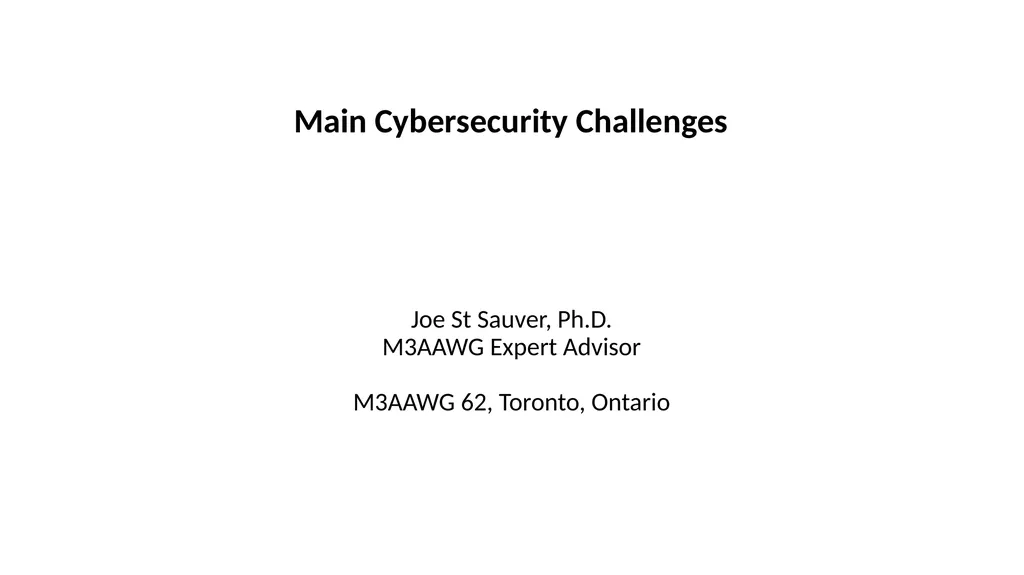Main Cybersecurity Challenges Joe St Sauver, Ph.D.
Author : olivia-moreira | Published Date : 2025-11-07
Description: Main Cybersecurity Challenges Joe St Sauver PhD M3AAWG Expert Advisor M3AAWG 62 Toronto Ontario Introduction Cybersecurity is an ongoing challenge for most sites Some challenges may be general while other challenges may be more
Presentation Embed Code
Download Presentation
Download
Presentation The PPT/PDF document
"Main Cybersecurity Challenges Joe St Sauver, Ph.D." is the property of its rightful owner.
Permission is granted to download and print the materials on this website for personal, non-commercial use only,
and to display it on your personal computer provided you do not modify the materials and that you retain all
copyright notices contained in the materials. By downloading content from our website, you accept the terms of
this agreement.
Transcript:Main Cybersecurity Challenges Joe St Sauver, Ph.D.:
Main Cybersecurity Challenges Joe St Sauver, Ph.D. M3AAWG Expert Advisor M3AAWG 62, Toronto, Ontario Introduction Cybersecurity is an ongoing challenge for most sites. Some challenges may be general, while other challenges may be more specific/technical. Today we'll outline some of the main general and specific/technical challenges we see, just to get the conversation started. Your organization may face different challenges. We hope you'll contribute your perspective about any topics we don't mention. We've endeavored to include references for any statistics we cite, since some of them are so high (or so low) as to be almost shocking. We've also endeavored to suggest basic approaches to mitigating some of these issues, when there is an obvious option to consider. Some challenges may be unsolved to-date. 2 Cybersecurity Challenges: General and Technical Outline 3 General Cybersecurity Challenges 1) Cybersecurity Leadership If cybersecurity isn't a priority for your organization's executives, it will be difficult to have a successful cybersecurity program. Senior cybersecurity staff members are also aging. Example: "A Looming Crisis -- The cybersecurity industry is on the brink of a leadership vacuum. With 34% of the workforce now aged 45-54, the sector faces an imminent challenge as senior professionals approach retirement, yet 40% of organizations still report vacancies at the senior manager or director level. [...] Organizations are struggling to build a strong leadership pipeline, which is essential for maintaining stability in an increasingly complex threat environment." [emphasis added] [ref: https://www.isaca.org/resources/news-and-trends/isaca-now-blog/2024/the-hidden-culture-crisis-and-human-burden-undermining-cybersecurity-resilience ] See also "The Cybersecurity Leadership Crisis Dooming America’s Companies," https://www.forbes.com/sites/bobzukis/2024/07/26/the-cybersecurity-leadership-crisis-dooming-americas-companies/ Mitigation: Succession planning? Leadership development programs? 5 2) Inertia (Obsolete/End-of-Life Legacy Systems Remaining In Use) Risk: Obsolete systems and software may no longer be getting vendor security patches, leaving those systems vulnerable to known attacks. This issue has been flagged by national cybersecurity authorities, see for example https://www.ncsc.gov.uk/collection/device-security-guidance/managing-deployed-devices/obsolete-products A Specific Looming Example: "After October 14, 2025, Microsoft will no longer provide free software updates from Windows Update, technical assistance, or security fixes for Windows 10." [ref: https://www.microsoft.com/en-us/windows/end-of-support?r=1 ] An estimated 400 MILLION systems do not meet Windows 11 minimum requirements [ref: https://www.theregister.com/2023/10/27/microsoft_petitioned_to_keep_windows/] Mitigation: When possible, replace obsolete hardware and software outright. If that's not possible, consider shifting to currently supported operating systems/applications with lower minimum requirements (this may not always be possible, and may come with substantial training and support costs – going from Windows to Linux can be a BIG jump) 6 3) Monculturality Risk: If an incident occurs













